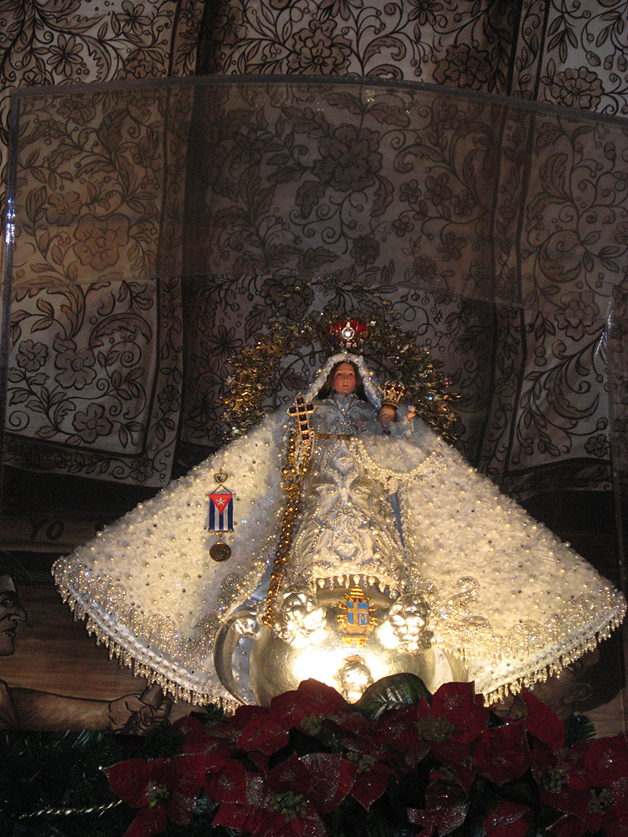
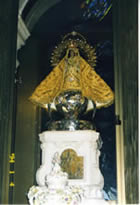 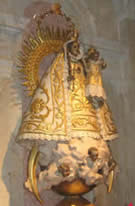 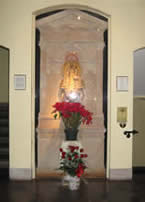 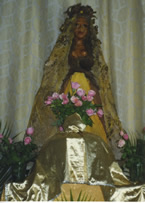
"Original" image in the Sanctuary of El Cobre (left); Handcarved "replica" in a Washington Heights church, NY City, 1929 (center left and center right); Ochún, Santiago de Cuba, 1997 (right).
|
 |
< 5 >
| < |
|
Image of Our Lady of Charity in Miami hermitage, December, 2007. |
The modern doll-like image of the Virgin displayed in the hermitage of Miami is said to be a "replica" of the "original" one in the Sanctuary of El Cobre.
Although similar in size the images are not exact look alikes. Most notably, the Miami double is distinctly racially white while the restored antique image in El Cobre is darker and racially ambiguous (said to be triguena or mulata). The middle-class kitchy replica is also dressed in white--as if to emphasize its whiteness and purity--while its "miraculous" counterpart in Cuba is dressed in yellow (the color of yet another double in this hall of mirrors, Santería's Ochún). Other attributes such as the cross, the crown, the halo, the silver cup base on which the figures stand are similar. The Virgin Mother in Miami, like her counterpart in El Cobre, is also lavishly represented as Queen. Although a "replica" of the "original," the image presiding over the Miami hermitage was sent directly from Cuba, so she is, literally, "made in Cuba."
The distinction and play between the concepts of "original" and "replica" conjures multifarious associations. Much political significance was attached to the event of the image's almost "miraculous" arrival in Miami after being smuggled out of the island through diplomatic venues. Some "30,000" Cuban emigrés expectantly awaited the Virgin's image in a stadium on September 8th, 1961 for the first major staged collective celebration in exile of her annual festivity. Such stories, memories and associations constitute part of the aura of an image or its iconic significance for a community.
Below left, is the "original" image in the shrine of El Cobre and to exteme right is an idiosyncratic modern image of Ochún in Santiago de Cuba. In the center, yet another "replica" of the "original" image in El Cobre, this one found in NYC. The latter is not a "dressed" image, however. It is a finely handcarved piece, made in the 1920s by a Catalan sculptor, Ramón Maten. The image was carved from a single piece of "Cuban" wood (therein lying its claim to "authenticity").
The NYC replica of the Virgin of Charity represents a somewhat different--and less politicized--trajectory than that of the replica in Miami. The image made its way from Spain to Cuba and then to New York City in 1929 where it now stands in a niche in the vestibule of the parish church "Our Lady of Esperanza" (624 W. 156th St.). While earlier in the century the parish may have served a Cuban community in the Washington Heights area, it currently serves the Dominican community residing in that district.
This handcarved image in Washington Heights does not presently have any "aura." Aside from its regular religious function in a wider pantheon of saints in the church, its value also seems to be historical and aesthetic, as indicated by the explanatory note on the wall and its exhibition behind glass. The image may still have a few individual devotees of its own, as the flower offerings show, but it does not have any strong iconic significance for the present day Caribbean Hispanic community of that parish. That does not mean, however, that it never had political significance or iconic power. The commission and arrival of this archetypical religious "Cuban" image to this particular parish in the USA during the late 1920s may have had a charged history of its own that is by now forgotten.
|
